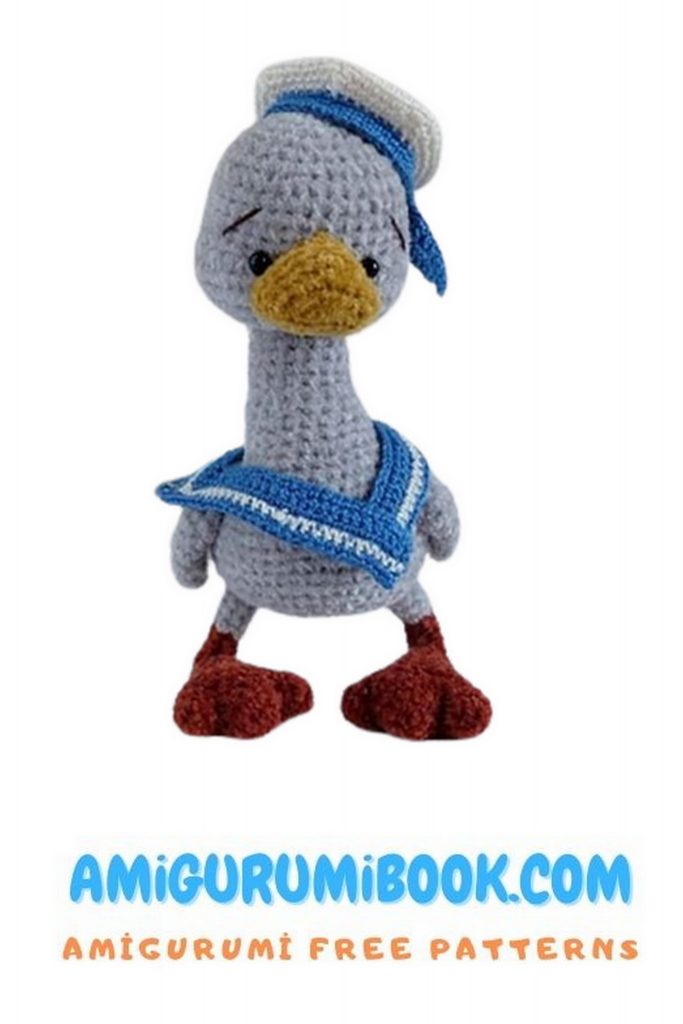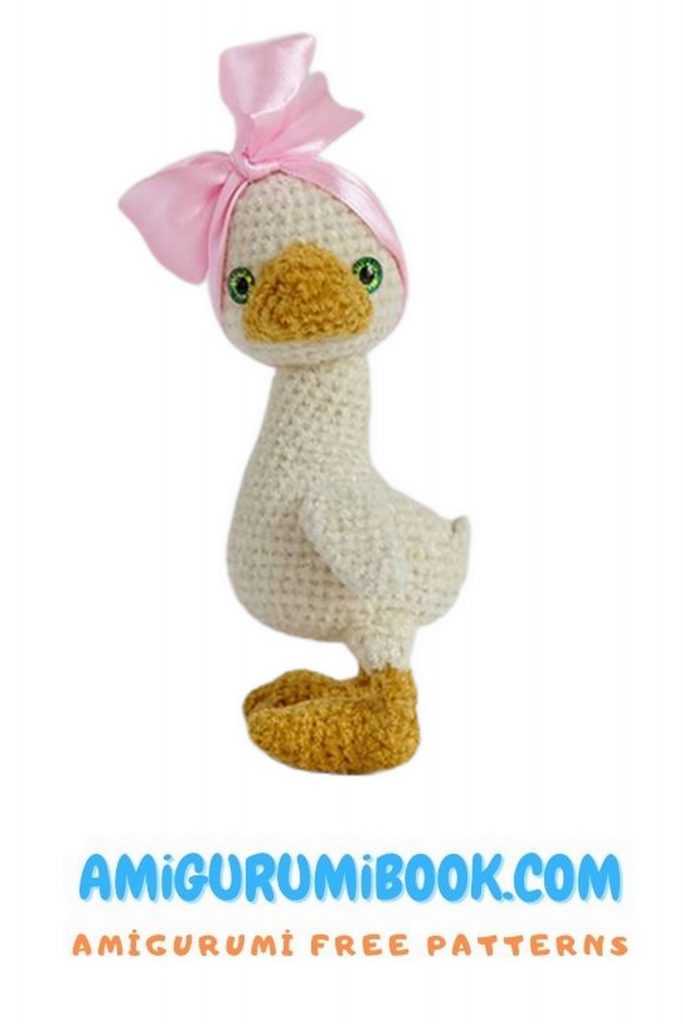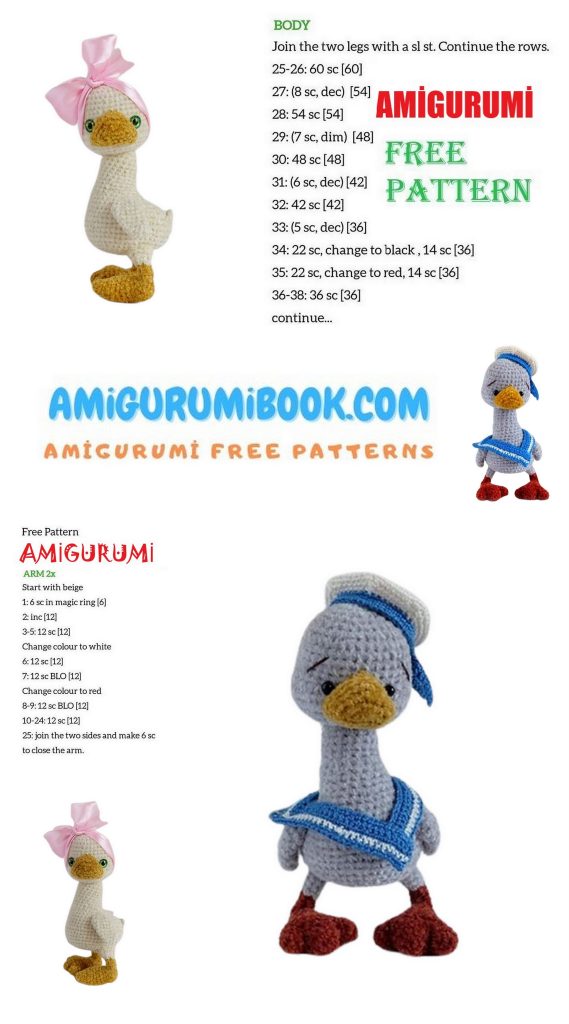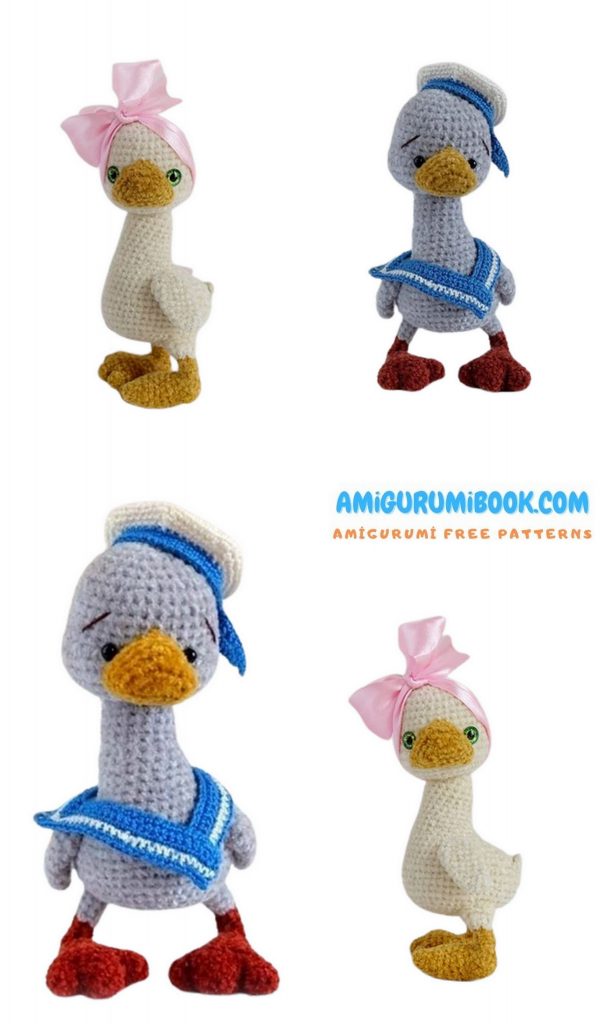I continue to share amigurumi free patterns. Goose amigurumi free pattern is waiting for you in this article.
Materials:
You can knit from absolutely any yarn in any of its combinations.
You will need at least 2 colors (head, body + paws, beak)
Or 3 colors (head, body + beak + paws)
Colors for your taste and color.
Also, if you have a desire, you will need to buy cotter pins.
For toys made of yarn up to 400m/100 gr. size 1.6 * 20 mm, smaller footage, including a bun 2 * 20 mm. In total, you will need 3 cotter pins (1 head and 2 wings)
They will need disks, their size depends on the yarn from which you plan to knit.
– thin yarn in the region of 500-600 m / 100 gr. in the wings, disks are approximately 6-8-9 mm (I have 8) – 4 pcs. And in the head-neck 18-20 (head) 15-18 (neck). 1 in the head of the disk, 1 in the neck.
Accordingly, the smaller the footage of yarn you have, the larger the size of the disks will be needed. In a bun, I take a combination of 35 (head) – 30 (neck).
For reinforcement, you will need a wire, you will also need a medical plaster for it.
Well, do not forget about the eyes, filler, thread for tightening, needles, round nose pliers (for cotter pins). I’m sure you have many of these.
ATTENTION!!!
It is assumed that you have the skills of cotter fastening in a toy!
In this description, details of this and any other type of fastening are not provided!

Abbreviations:
ch-chain
sc – single crochet
INC – increase
DEC-decrease
DC – double crochet
SL-ST slip stitch
PATTERN


Head:
Magic ring into 6 sc
1p) INC * 6 times = 12 sc
2p) (1 sc, INC) * 6 times = 18 sc
3p) (2 sc, INC) * 6 times = 24 sc
4p) (3 sc, INC) * 6 times = 30 sc
5p) (4 sc, INC) * 6 times = 36 sc
6-11r) straight 36 sc (6 rows)
12p) 8 sc, INC * 4 times, (INC, 1 sc) * 3 times, put extra. Draw marker (center of muzzle), (1 sc, INC)*3 times, INC*4 times, 8 sc = 50 sc
13r) straight 50 sc
14r) (3 sc, DEC) * 10 times = 40 sc
15p) (8 sc, DEC) * 4 times = 36 sc
16r) (4 sc, DEC) * 6 times = 30 sc
17r) (3 sc, DEC) * 6 times = 24 sc
18p) (2 sc, DEC) * 6 times = 18 sc
19r) (1 sc, DEC) * 6 times = 12 sc
We fill the head tightly enough, do not close. If you knit without a cotter pin, then we will continue the body with the same thread, if you close it, then we leave the thread long enough to close the hole.
I can’t help about safe eyes, because I put my eyes on after tightening, I think in the region of 10-12 rows somewhere. It is necessary to look at the toy and the size of the eye.



Beak:
Chain of 6 ch
1p) INC, 1 sc, 3 sc in 1 loop, 1 sc, 3 sc in the last loop, on the other side of the chain 4 sc = 14 sc
Instead of a traditional circle, you get a kind of triangle.
2p) INC, 3 sc, 3 sc in 1 loop, 3 sc, INC, 5 sc = 18 sc
3p) straight 18 sc
4p) 1 sc, 3 sc in 1 loop, 10 sc, 3 sc in 1 loop, 5 sc = 22 sc
5p) straight 22 sc
We leave the tail of the thread sufficient for sewing the beak to the head. First we sew the beak, by the end of sewing it must be stuffed. Add. the marker on the muzzle is hidden under the beak, this is the middle of the muzzle, and when sewing on the beak, we focus on it in order to sew it evenly. The upper part of the beak must match the ext. marker. Remove it after stitching. The tail from sewing on the beak, and to the head.
Next, we make braces.
We place needles on the sides of the beak. We take a large needle with a strong thread, it is better to match the color of the head. I have a brown one so you can see.
We fix the thread at the bottom of the head under the chin, as close as possible to the neck, as close as possible.
We insert the needle at point 1 (under the chin), we bring it out at point 2 (the edge of the eye tightening, the place marked with a needle), we insert it at point 3 (the second edge of the tightening) and we bring it out at point 1 (under the chin). We stretch the thread and fasten it below the chin. You should get a dimple for the eye. We repeat the same with the second eye.
After the tightening is done, we insert the cotter pin down the head, with a slight shift forward (see photo). The pin should be about 1/3 of the head, maybe a little more.
You should, as it were, put it under knitting, but a little, about 3 mm a little more, a little less.
After the head is completely stuffed, the cotter pin is inserted, we close the head with reductions to the end, the tail from the thread, and into the head.
If you are making a head without a cotter pin, then tightening and just leaving the head open, you will just continue to knit the neck.
Neck, torso:
Magic ring into 6 sc
1p) INC * 6 times = 12 sc
2p) (1 sc, INC) * 6 times = 18 sc
3-7p) straight 18 sc (5 rows)
after 4 rows, you need to install a cotter pin, the marker thread goes back in the middle of the head. If you do not have a cotter pin in your head, you knit 1 row of 12 sc onwards, starting with 2 rows of description.
8p) 5 sc, INC, 7 sc, INC, 4 sc = 20 sc
9p) straight 20 sc
10p) 7 sc, INC, 7 sc, INC, 5 sc = 22 sc
11r) straight 22 sc
12p) (5 sc, INC) * 3 times, 4 sc = 25 sc
IMPORTANT!!! The marker should be at the back in the middle of the head, if it has shifted, you need to make offset loops. Stuff the neck as needed.
Starting the body
13p) INC*2 times, 22 sc, INC = 28 sc
14p) INC*4 times, 3sc, INC, 15 sc, INC, 2 sc, INC*2 times = 36 sc
15p)(1 sc, INC)*4 times, 24 sc, (1sc, INC)*2 times = 42 sc
16r) straight 42 sc
Your marker thread will always shift slightly to the side due to increases (to the right), this is normal.
17p) INC * 6 times, 36 sc = 48 sc
18p) (1 sc, INC) * 6 times, 36 sc = 54 sc
19-21r) straight 54 sc (3 rows)
if you mount the wings, they will need to be installed in the area. 18 rows.
In which row the wings should be knitted, I don’t know, since I didn’t do it, but I think that this is the same row as for the cotter pin.
The sewn-in version of the wings, we do it after we fill and close the body completely, in this case we orient ourselves visually.
22p) (DEC, 1 sc) * 5 times, DEC, 37 sc = 48 sc
23r) straight 48 sc (1 row)
if you knit paws, then 23, the most successful row. The paws are knitted along the front of the body, in a row in one lace.
24r) (6 sc, DEC) * 6 times = 42 sc
25r) (5 sc, DEC) * 6 times = 36 sc
26r) (4 sc, DEC) * 6 times = 30 sc
27r) (3 sc, DEC) * 6 times = 24 sc
28r) (2 sc, DEC) * 6 times = 18 sc
We stuff the body, pushing it tightly enough into the neck. If there is reinforcement of the paws, then the body does not close, it does not stuff much, so that it would be convenient to insert the wire.
29r) (1 sc, DEC) * 6 times = 12 sc
30r) DEC* to the end or close in any way convenient for you.
We leave a sufficiently large tail of the thread for knitting the tail of the duck.
Wings:
Magic ring into 5 sc
1p) 2 sc, 3 sc in 1 loop, 2 sc = 7 sc
2p) 3 sc, 3 sc in 1 loop, 3 sc = 9 sc
3p) straight 9 sc
4p) 4 sc, 3 sc in 1 loop, 4 sc = 11 sc
5p) straight 11 sc
6p) 5 sc, 3 sc in 1 loop, 5 sc = 13 sc
7p) straight 13 sc
8p) (1 sc, DEC)*4 times, 1 sc = 9 sc
There are several options for closing the wings, it can be folded in half and knit sc, in this case the wing is simply sewn to the body. If you want to put the wings on cotter pins, then the winglet is closed with reductions to the end or simply pulled together after installing the disc and the cotter pin into it. The pin is inserted from the top edge.
I did not stuff the wing of the velor goose. Perhaps, if the toy is knitted from thicker yarn, then stuffing will be necessary, you have to look.
Do not forget that the wings are right and left when installing cotter pins.
We output the cotter pin in the 7th or 8th row, it depends on the size of the disk in which one it will, but better in 8.
Paws:
If you reinforce the legs, then this must be done in the process of knitting the legs, in this case the body closes only after the reinforcement is inserted into it.
For the toes we make 2 blanks
End finger:
Magic ring into 6 sc, straight 6 sc – 1 row
(tear off thread)
middle finger
Magic ring into 6 sc
1p) (1 sc, INC) *3 times = 9 sc
2p) straight 9 sc (tear off the thread)
Once again we start knitting a small finger
Magic ring into 6 sc
1p) straight 6 sc
2p) We connect all the fingers together.
We put the marker thread at the beginning of the row.
3 sc (on the first finger, the one that started knitting), 5 sc (on the big middle finger), 6 sc on the (extreme, third finger),
4 sc (on the big middle finger) and 3 sc (on the first finger) = 21 sc
3p) straight 21 sc
4p) 9 sc, DEC, 8 sc, DEC = 19 sc
5p) 8 sc, DEC, 7 sc, DEC = 17 sc
6p) 7 sc, DEC, 8 sc = 16 sc
7p) (DEC, 6 sc) * 2 times = 14 sc
8p) (DEC, 5 sc)*2 times = 12 sc
Now is the time to make the reinforcement of the foot, and stuff it a little (fingers) Knit the heel in reverse rows
9p) 6 sc, ch – unfold
10p) we begin to knit about the second from the edge of the loop 4 sc, ch – unfold
11p) again from the second from the edge of the loop 2 sc, ch – unfold
We transfer the marker thread to the beginning of the row, now we must make 12 sc by tying the heel in a circle
12r) 2 sc, (on the side), 6 sc, (on the front), 2 sc (second barrel), 2 sc (on the back of the heel)
13p) DEC*6 times = 6 sc
Now is the most convenient moment to fill the leg to the end.
14-16r) straight 6 sc
We change the color to white or another color that the gosling is knitted with.
17r) (1 sc, INC) * 3 times = 9 sc
18-19r) straight 9 sc (2 rows)
If you are doing reinforcement, now you need to insert the wire into the body
(it should not be stuffed) and connect with each other. If you have long ends of reinforcement, then you can not bite them off, but twist them together and bring them out in the ass, so that the gosling would keep balance even better. Only after this the body is stuffed and closed to the end, and then the paws are sewn to the body.
For reinforcement, you can use any wire. I wrap it with a medical plaster. This will give it strength and a small volume. If necessary, the leg, the thigh is stuffed additionally. It depends on the yarn from which you knit the goose.
Tail:
We bring out the thread left after closing the body in the ass, in the middle.
Do 3 ch turn Goose head up and facing you. Work 1 dc (double crochet) into a st in the body just to the left of the chain exit point.
Now we fix it all with a connecting column, putting to the left, everything that we have on the hook.
Those. everything that you have tied lay on its side and attach to the body.
We turn the Goose upside down, but still facing us. And we knit 6 dc at the base of the initially dialed ch. We fix it with a connecting post, putting the posts in the other side now. We hide the tail of the thread from the tail of the Geese in the body.
To make it clearer, the tail is tied on the body.